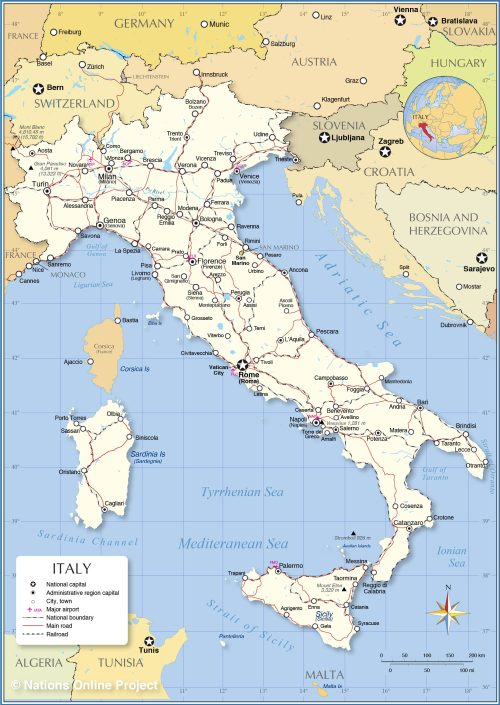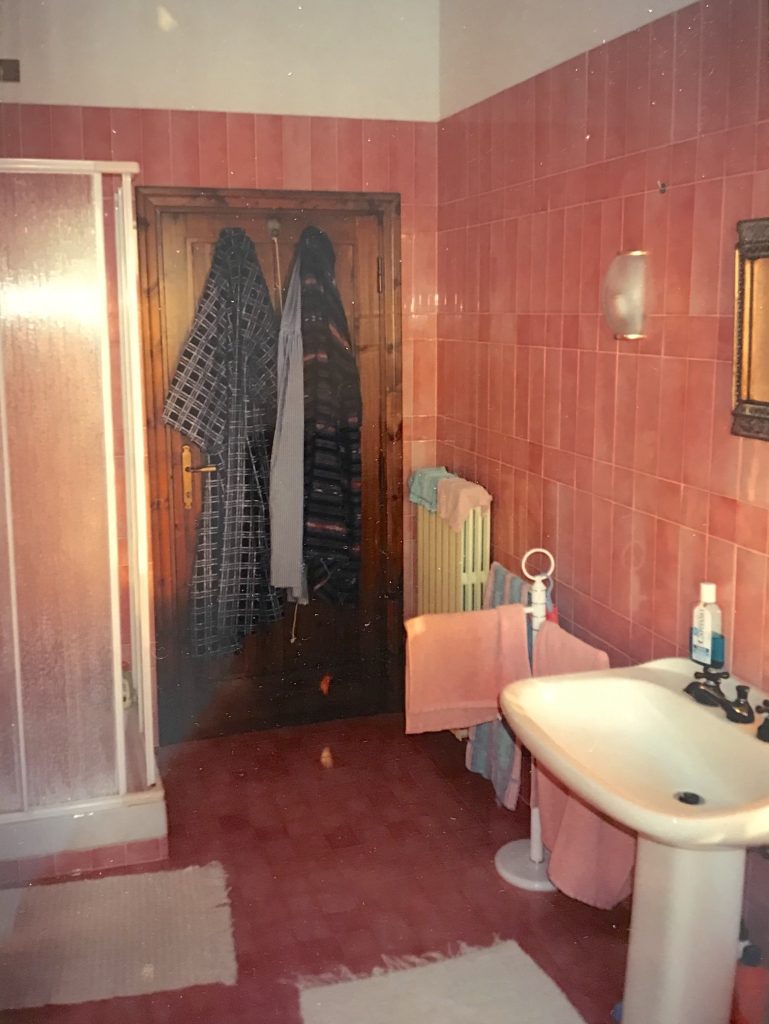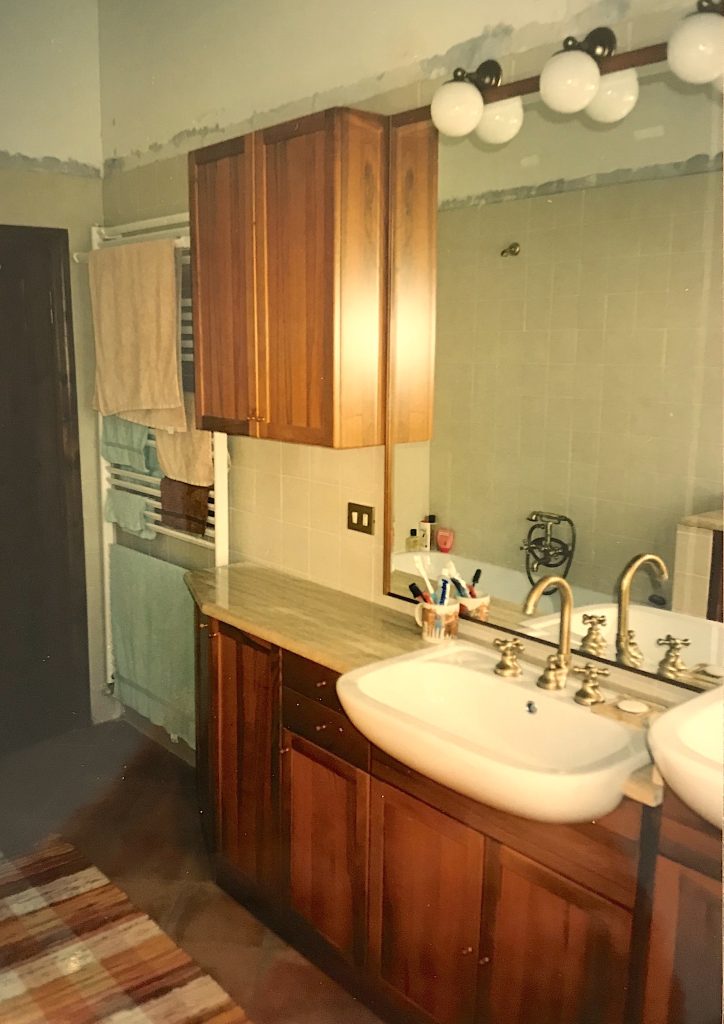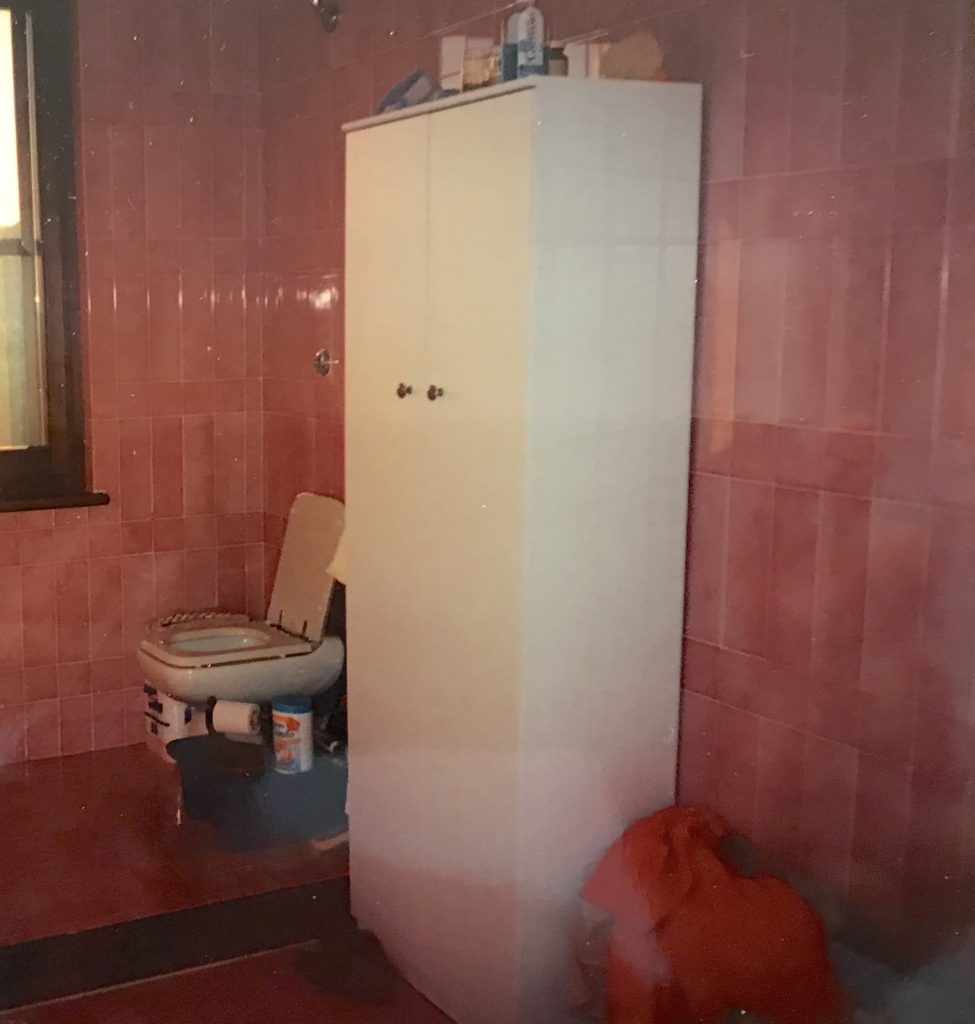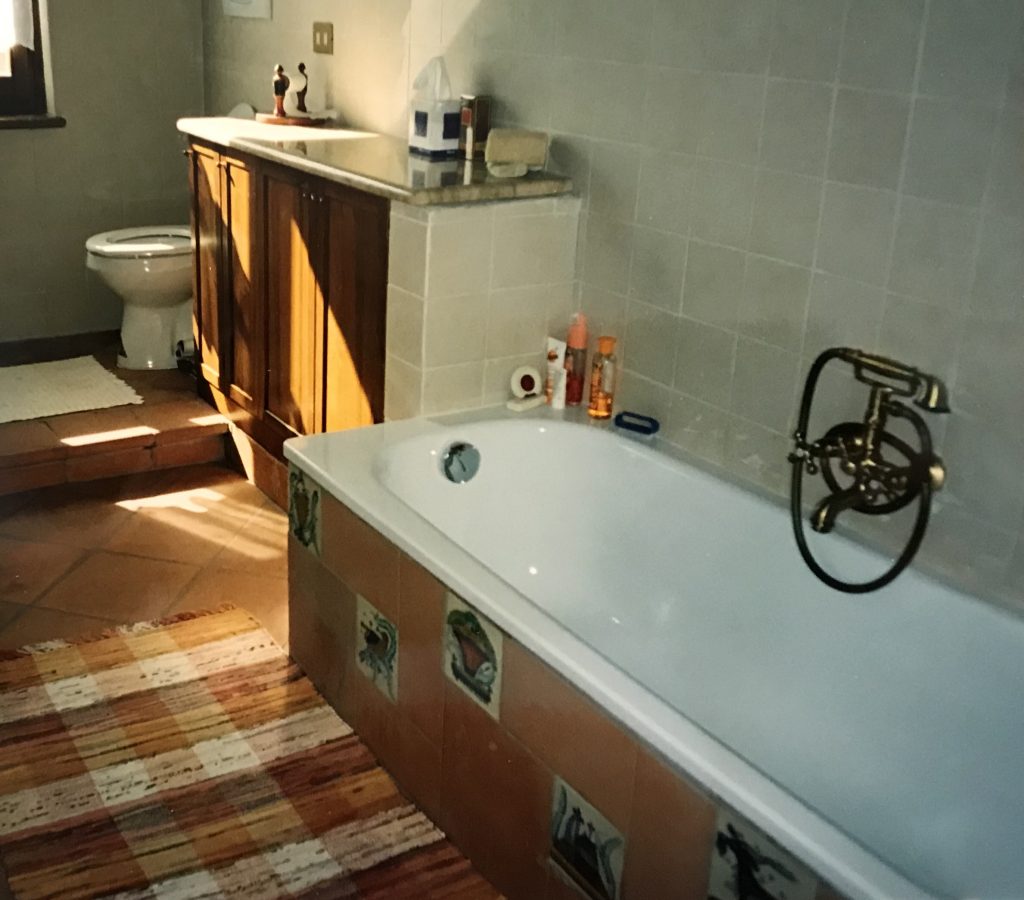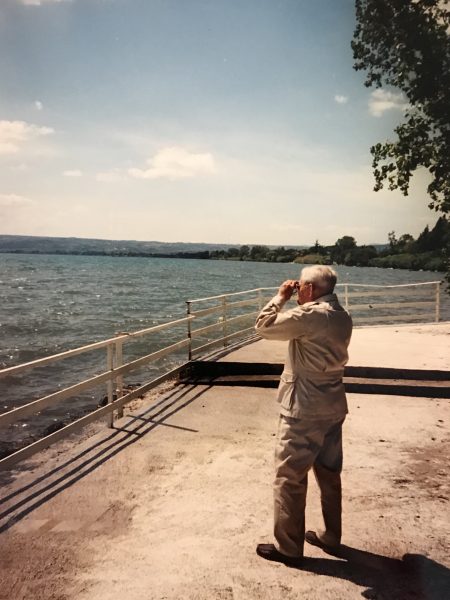#42: Italy, 1998Fare Thee Well
The year 1998 brought expected and unexpected challenges. The renovations of our old farmhouse continued. Guests arrived almost every month, and my Dad returned for his third visit. He was ever an enthusiastic traveller, from his days in post-war Japan, through countless Elder Hostel trips to time spent with us in faraway places. If there was a voyage on offer from Antarctica to Iceland, he was keen to sign up. Here are some excerpts from 1998 letters to family.
[As always, you can click on photos to enlarge them.]January 28
We had a nice, sharing visit with Russell’s young colleague from our Central Asian years. Now we’re looking forward to R’s brother Bob and wife Sylvia coming in late February.
A couple days after Igor left, I had a relapse of the respiratory infection which started last Thanksgiving. Another three days in bed and not symptom-free ’til the end of last week. Now I’m pruning olive trees. The traditional shape is like an upside-down umbrella so that maximum sun can get to every leaf. While Russell was away last week in Manila, I decided to concentrate on the young trees (the majority) and let him take on the big guys when he gets back.
Russell was training the legal department of the Asian Development Bank on managing technical assistance. This project was a direct outgrowth of one of the two books he wrote while at the East-West Center in Hawaii.
March 5
We’ve now got a satellite dish (parabola in Italian) on the roof: hundreds of channels, including those in French, German, Arabic, Polish and Turkish. Kinda weird to hear John Wayne speaking Arabic…
We dug a vegetable garden, planning to have several types of non-Italian onions plus okra, Chinese snow peas, leaf lettuce and dill — all things we can’t get here (thanks to Dad for sending seeds from South Carolina). Our policy has always been to grow what we can’t get where we are. When we lived in Almaty, we grew broccoli and fennel — no need to sow those in Italy!
We’re also planting a mimosa beside the drive, so spring will offer a cascade of fluffy little yellow balls above the daffodils.
Day excursion to the Orebetello Peninsula, almost directly west of us in the Tyrrhenian Sea: Formerly an island, now connected to the mainland by three sandbars (one of them large enough to hold a small town) and crowned by a 2000+ foot mountain.
April 7
Russell’s trip to Tashkent was challenging, demanding and successful. He found the city in worse shape than it was only two years ago — politically, economically and physically. R is part of a consulting team advising the Uzbekistan Government on how to create a more attractive climate for foreign investment.
While he was gone, I got started remodeling the master bathroom. The one we inherited was tiled in screaming pink, both walls and floors, so bright it almost gave you a headache when you brushed your teeth in the morning. (The enclosed photos don’t begin to do that wild color justice.) The bathroom was also minimally equipped — small, plastic-walled shower, no tub, low sink, no cupboards at all, a tiny mirror and two 40-watt lights. The masons ripped out all the tile and used a small jack-hammer to remove the cement flooring right down to the I-beams which support the second floor. By the end of the day, there was cement dust everywhere, not only all over the second floor, despite closed doors and plastic sheets over furniture, but even all over the living room, where bits of cement and dust had drifted down through the ceiling. Luckily, I had removed everything from the living room in the section under the bath — it could have been a disaster.
The following day, the masons carried out most of the debris and tunneled through walls for new wiring and plumbing, including the toilet tank which is hidden inside the wall. Then they piled up some rubble and covered it with sand to support the tub, which they enclosed with terra cotta tiles highlighted with six hand-made decorative tiles we’d bought in Mexico years ago. Next came wall tile, a textured beige, vey rustic and much lighter and brighter. (Enclosed photos make the color appear less warm in tone than the reality, and the wall tile lacked the decorative border on top.) Finally, they laid 12″ terra cotta floor tiles on the diagonal.
Masons finished, Marco the Magic Plumber (whom you’ve met in previous letters) hooked up the toilet, two sinks and the tub, all of which have brass fixtures, more in keeping with this rustic house. The lower cabinets are taller, so no more backaches from bending way over — natural wood with travertine marble on top. I know it sounds jazzy to have marble in the bathroom, but that’s what everyone does here — cheaper than the man-made stuff. The entire space over the sinks is mirrored with five 40-watt lights above, so we can at last see to shave and put on makeup. A six-foot, heated towel rack replaces the former radiator.
It snowed during the construction! It’s very unusual to have snow even in the depths of winter, let alone spring. Here, the snow didn’t stick, but it did in slightly higher Amelia, and all the hills above the town had thick, wooly, white caps. The Apennines were absolutely drenched in it, and their snow stayed throughout the week, while the lower-level stuff was gone in a day.
Once the construction was done, I sat down and completed another chapter of the book. That leaves one to do, plus the denouement, so I’m in the home stretch, even if I didn’t finish by Christmas as originally planned. I was hoping then to finish by Easter, but monthly houseguests, construction and other stuff are getting in the way. I estimate it’ll take about two more woman-weeks of work for a first draft.
Despite the snow, all the late-spring flowers have opened with gusto — white and purple bearded iris, violet Dutch iris, tulips in many colors, pansies, primroses and various daisies. When we come down the driveway, it really feels like Easter-time.
May 1
Easter Monday found us touring old Amelia structures which are normally closed to the public. We especially liked the ancient Roman cistern and Chiesa di San Secondo o della Buona Morte. The cistern is far grander than anything we had imagined. Amelia/Amerina was an important town in Roman times, with a major Roman road coming through. Under the main piazza high in the old town is a ten-chamber cistern, each chamber over 18 feet high. The entire structure is c. 200′ x 70′ with a capacity of 155,384 cubic feet. The cistern was still in use via public and private wells into the middle of this century.
The Chiesa is a medieval church outside the walls of old Amelia. The dying were brought here to be cared for by monks who then buried them in the cemetery beside the Chiesa. This monastic order was dedicated to easing the physical and spiritual suffering of the dying. There’s a famous ceiling fresco of Death, depicted as a skeleton with various symbols. Although it was a bit macabre, it was also moving to see the compassion of a dedicated group of men in an era when death was much more integral to life than it is today.
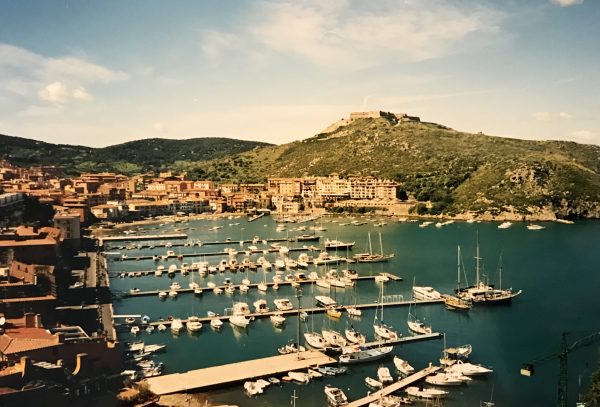 We had a lovely time celebrating Russell’s birthday at Porto Ercole, a coastal town on a peninsula almost due west of here. The town used to belong to the Spaniards, who built three forts guarding the anchorage. Two of these forts have been converted into condos, and the other is being renovated as a maritime museum. The condo conversions save the historic structures. Rich folks from throughout Europe get an exclusive apartment with an amazing view and privacy. The income preserves the forts and makes the museum possible. The hoi polloi like you and me can explore the outer walls and fortifications, which are pretty spectacular.
We had a lovely time celebrating Russell’s birthday at Porto Ercole, a coastal town on a peninsula almost due west of here. The town used to belong to the Spaniards, who built three forts guarding the anchorage. Two of these forts have been converted into condos, and the other is being renovated as a maritime museum. The condo conversions save the historic structures. Rich folks from throughout Europe get an exclusive apartment with an amazing view and privacy. The income preserves the forts and makes the museum possible. The hoi polloi like you and me can explore the outer walls and fortifications, which are pretty spectacular.
[Porto Ercole became one of our special places, where we often returned with visitors or just the two of us.]
June 23
Every day was delightful during Dad’s visit, both on the trip south and back here for a week. We were able to stay in Rome for a few days, thanks to not having a flash flood in the living room. [See Post #40.] On the first afternoon, Dad tossed a coin into Trevi Fountain to ensure his return.
After a good hotel breakfast the next morning, we took a taxi to the Vatican Museum. I parked Dad and Russell at the end of a long line snaking up the hill and went to ask the guard how extended the wait would be, sharing my concern about my father being 88 and standing in the heat. “There’s no wait for you, Signora,” he said in Italian. “Bring your father here to this special door.” AND we got to ride up in the fancy, wood-paneled, giant elevator normally off-limits to tourists (with seats! — wonder if that means they’re for ancient Cardinals’ bottoms…). Once upstairs, we walked through room after room of Vatican treasures, even spotting Amelia on a map commissioned three hundred years ago. The highlight, of course, was the Sistine Chapel. Fortunately, there wasn’t a large crowd, so we could sit on a bench and see these amazing frescoes with ease. The restoration is almost complete, and the colors are truly amazing. It reminded us of visiting Mt. Vernon after curators had discovered that George Washington used bright colors in his house.
The next day, we went to Castel San Angelo, originally Hadrian’s tomb but converted to a fort by the popes. They connected it to the Vatican by an elevated, crenelated walkway so they could run to safety when trouble threatened. Inside are many lavishly decorated rooms, as well as the old papal treasure, housed in the vault where Caesar’s body once lay. Wonderful views across the city when you finally get to the top.
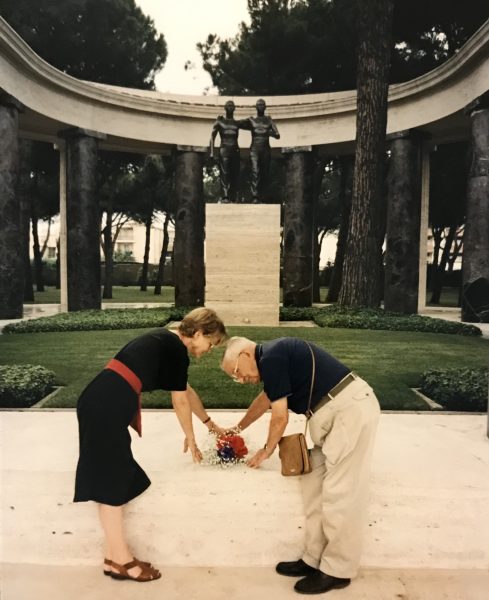 The following morning, we drove to Anzio, the site of an Allied landing in WWII. At the museum, we learned that the disembarking 40,000 men suffered 28,000 casualties. The situation was so bad that the authorities kept the news from the British and American publics, because they were afraid of losing popular support. We laid flowers at the American Cemetery, a beautiful and impressive site, well cared-for with U.S. taxpayer funds on land granted in perpetuity by the Italian people in gratitude for being liberated.
The following morning, we drove to Anzio, the site of an Allied landing in WWII. At the museum, we learned that the disembarking 40,000 men suffered 28,000 casualties. The situation was so bad that the authorities kept the news from the British and American publics, because they were afraid of losing popular support. We laid flowers at the American Cemetery, a beautiful and impressive site, well cared-for with U.S. taxpayer funds on land granted in perpetuity by the Italian people in gratitude for being liberated.
Leaving Anzio behind the next day, we drove to Naples through beautiful countryside and wonderful weather. We were almost there, literally within the city limits, when our car inexplicably broke down in a tunnel. A little nerve-wracking, but R managed to nurse it through the rest of the tunnel and onto an off-ramp which led to a service station. We ate sandwiches at the bar while we waited for the mechanic to return from his lunch, only to discover that he couldn’t find anything wrong with the car. It never gave us any trouble after he manually caused the motor to race, so it must have been something in the fuel line.
On to our hotel, with its fine view across the Bay to Vesuvius. We decided not to let the day be a total waste and went down to the waterfront in the late afternoon for pastries and coffee at an outdoor cafe. Naples is famous for both, and we can testify the reputation is well-deserved.
The following day, we took a ferry to Ischia, one of the islands in the Bay of Naples, and the next morning, a train around the Bay to Pompeii. We spent a half-day walking among the ruins, contemplating the eruption that destroyed it and the casts of people who didn’t survive. It was a very hot day, and I was happy to get to the ancient baths and gymnasium, where they’ve tucked a restaurant into a courtyard. We ate caprese salads (invented in Capri) — fresh tomatoes with buffalo-milk mozzarella, garnished with fresh basil and extra-virgin olive oil — the perfect meal for a hot summer day.
Sorrento on the Amalfi coast filled our next day — lovely to be in clean air after the pollution for which Naples is infamous. Dad’s birthday fell on the following day, and we began with gifts on the roof terrace as we ate breakfast overlooking the Bay. After a visit to an art museum in a former palace and garden atop one of Naples’ steep hills, we celebrated again with dinner in a restaurant famous for its local food. Compact, run by a family with a limited menu based on what’s good at the markets that day.
Then it was time to pack up, store a lot of our gear at the hotel and take the hydrofoil to Capri. The island perches on cliffs like those at Dover, some over 400 feet high. The boat docks below and you take a taxi up, up, up into the town. Then you walk to your hotel through streets too narrow for regular vehicles to pass. Meanwhile, your luggage is brought by a sort of modified golf-cart. Our small hotel inside its own garden provided large rooms with balconies and beautifully tiled baths. The mother of the owner, a real character, suggested one day that she and Dad should get engaged because they were both too young to live alone!
Capri is still beautiful after more than 2000 years as a resort. The ancient Romans had villas there. Wealthy Europeans came in the 19th century, and the Beautiful People re-discovered it after WWII. Now tour groups come on day trips, but Capri is unspoiled. The town is charming, the scenic beauty is breathtaking, and there’s a fair amount to do if you can’t sit still and breathe in the ambience.
Succeeding days were filled with window-shopping everything from luxury goods to simple sandals, a trip to the much less-developed town of Anacapri, a walk to Villa Jovis built by the Emperor Tiberius. We’d planned to visit the Blue Grotto, but the seas were running too high and no tour boats were going out. The entrance to the Grotto is only a meter high; if there’s any sea at all, it’s impossible to go inside. We went to the Parco Augusto and the Cistercian Monastery instead. The Park is the site of the Emperor Augustus’s villa, now in ruins but with spectacular views up and down the coast. The monastery now houses a school and an art exhibit.
After a good night’s sleep, it was back to Naples, pick up our stuff left at the hotel and drive to Amelia. A long day, but not too long, and the weather was perfect for a drive through the Italian countryside. We had time to go get Zack, happy to see us but not too frantic from his first stay at a boarding kennel. Three days of various experiences around here, then we hosted a goodbye English-style tea with twenty local friends all glad to see Dad again (he picked up a few prezzies too). He left the next day on a 3:00 plane, so we had a leisurely morning and a nice lunch en route to the airport.
Sad to see Dad go, but happy that he’s still so full of life. We drove back along country roads, filled with memories and the nice kind of weariness that comes from sharing days with those you love.
[During our stay on Capri, we realized Dad was tiring easily and out of breath on steep streets. We suggested he see his doctor when he got home.]
August 4
We waited until today to write in hopes that we could report good news from Dad’s biopsy, but I’m afraid it wasn’t to be. He’s been diagnosed with a malignant tumor the size of a small walnut in his right lung. He’ll be seeing his oncologist next week, when we’ll know more about treatment and prognosis. Once we have that information, we’ll decide when would be best for me to come to South Carolina to be with him.
September 15
I spent ten days with Dad during the beginning of his cancer treatments. He’s receiving daily radiation and weekly chemotherapy. One oncologist reiterated that they are “cautiously optimistic” that they can arrest the tumor’s growth and maybe shrink it. During my stay, he was tolerating both treatments well, played bridge frequently, had a good appetite and a positive disposition. But this past weekend, he began to experience the inevitable side effects — sore esophagus, pains in arms and legs, mouth ulcers, lowered white blood cell count, etc. They’ve stopped the treatments for the time-being and will reassess later in the week whether to start again or not. They’ve given him medication for his discomfort and asked him to stay away from as many folks as possible while his white cell count is down. I’ll be returning asap.
October 30
Russell writes:
This installment is my turn since Nancy remains in Spartanburg with her dad. He’s lost weight and appetite, has experienced severe discomfort in several parts of his anatomy and has low blood pressure and wooziness upon sitting up or standing. Now he seems to be getting stronger. Last week he moved from the hospital to the nursing home at his retirement community. Yesterday, he moved back to his own apartment. Nancy will remain with him as long as needed.
March 1, 1999
Nancy writes:
After some weeks of medical care, Dad was fit enough to come back home. He seemed to be on an upward trend until Thanksgiving weekend, when after a series of small strokes, he was readmitted to hospital. He rallied again and returned home, though much diminished. The promise of early November was never to be realized, as his condition slowly worsened with metastasis and various complications. Mid-December saw him back in hospital, where he fell into a coma one evening and received the Last Rites.
[Dad awoke the next day, but an oncology specialist came to tell me that the cancer had spread to his brain. There was no hope, the doctor said and asked who should speak with my Dad about next steps. I replied that I would, but I wanted the oncologist to come too, in case Dad had technical questions.
We entered Dad’s room, and I sat beside his bed so we could hold hands. “We’ve come to a fork in the road,” I said, “but both forks lead to the same place. One fork is longer, while you continue to receive treatment and the side-effects that go with it. The shorter one takes us home, where you can have palliative care and no suffering.”
He asked the doctor a few questions and then turned to me. “Which road do you think I should take?”
“I can’t tell you that. Only you can decide what you want to do with your life.”
Ever canny, Dad asked, “If you had these problems, what would you do?”
I had to be the person he’d raised me to be. “I would take the shorter road.”
“Oh, good,” he said. “That’s what I want to do, but I didn’t want to disappoint you.”]
He returned home for the Christmas holidays, saying farewell to friends and family who gathered at his bedside.
[I cringed when one relative asked, “Leonard, are you afraid to die?”
“Nope,” came the answer. “I’m kind of looking forward to seeing what’s on the other side.”]
Russell arrived Christmas Eve from Moldova, where he’d been working off and on all fall, and we three spent a sharing Christmas together. The next day, it was as if Dad had accomplished all he wanted, so he saddled up and started to ride out. After a restless night, he passed away with Russell on one side and me on the other, holding his hands and saying, “I love you” over and over until he was gone.
Leonard Swing, that enthusiastic traveler, was off on his final journey.
[As I read the family letters from the last months of 1998, I couldn’t help but notice the ironies — Dad throwing a coin in Trevi Fountain so he could return, viewing him as “still so full of life,” our pleasure at having spent time with someone we loved. If we had known what would happen after his visit, would we have done more to make it special for him and for us? I’ll never know, but it’s moving to read those words, knowing what I know now and realizing we were sharing our last days.]

COMING NEXT MONTH
Italy: February – June, 1999
Bentornata
After four months in the States helping Dad on his last journey, I returned to our Italian home and the challenges there — another house remodel, Zack in surgery (twice!), contamination of our water supply — plus the fun of regional travels.

LET ME HEAR FROM YOU.
Please take a moment to share your thoughts.
Your comments help make the blog better, and I always answer.
* * *
If you enjoyed reading this post, I hope you’ll SUBSCRIBE by clicking on the button below. Every month, when I post a new excerpt from my life overseas, you’ll get an email with a link so you can read the next installment. Subscription is free, and I won’t share your contact information with anyone else. Your subscribing lets me know you’re reading what I write, and that means a lot.

